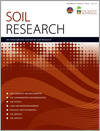SR17157Review and outlook for agromineral research in agriculture and climate mitigation
Agrominerals are naturally occurring rocks and minerals that can be used for re-fertilising soils exhausted of macro- and micro-nutrients. Heightened concerns for limited world P and K resources and the potential for applying a large amount of agrominerals to mitigate global warming has renewed interest of the subject. This review highlights the state of knowledge and potential future directions.




